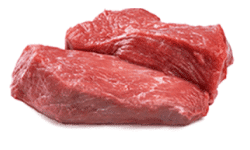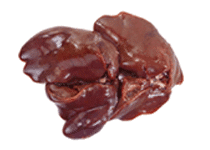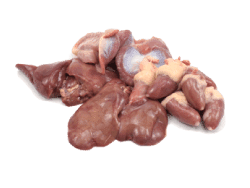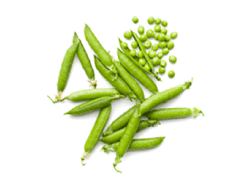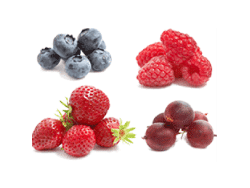

 |
FEEDING GUIDE FOR YOUR Labrador Puppy | |||
| AGE OF PUPPY |
WEIGHT OF PUPPY |
QUANTITY PER DAY |
MEALS PER DAY |
QUANTITY PER MEAL |
|---|---|---|---|---|
| 2-4 months |
15-18 Ibs (7-8 kilos) |
7/8 - 1 1/8 cups (200-250) |
4 | 1/4 cup (50-55 grams) |
| 4-6 months |
24-26 Ibs (11-12 kilos) |
1 1/8 - 1 3/8 cups (250-300) |
3 | 3/8 - 5/8 cup (80-100 grams) |
| 6-12 months |
50-60 Ibs (23-27 kilos) |
1 1/2 - 2 cups (350-450) |
2 | 3/4 - 1 cup (175-225 grams) |

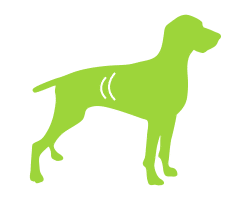

Ribs and hip bones are highly visible, and appear to just out when viewed from above
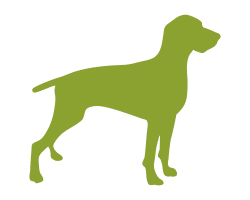

An outline of ribs can be seen and felt, the belly tucks up when viewed from the side, and there is a visible waist when viewed from above
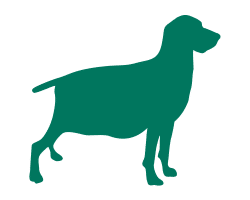

Dog has no waist when viewed from above, and stomach appears rounded when viewed from the side

So it’s up to you to learn how to read puppy food labels and be the final
decision-maker on your puppy’s nutritional needs.
There are six primary nutritional areas to focus on, and each has an ideal threshold:
WATER INTAKE
PROTEINS
CARBS
FATS
VITAMINS & MINERALS
RECOMMENDATIONS
SUPPLEMENTS
A puppy’s energy outputs and needs will tell you more about nutritional values.
To help Lab owners, the Association of American Feed Control Officials
(A.A.F.C.O.) recommends owners follow nutritional guidelines for things like
“Nutrient Growth and Reproduction Adult Maintenance, ” “Minimum Adult
Maintenance,” and “Maximum Adult Maintenance.”
However, these are only guidelines, and you should be varying these six nutrients
based on your dog’s individual needs and behavior. It’s best to work with a breeder or
your vet to ensure you get these levels correct.

The source of protein matters when considering a
high-quality diet. A lower quality dog food may contain
protein, but many brands use fillers that don’t
contain protein from the right sources.
Protein should make up around 22% to 30% of puppy
food for adequate growth levels. For adult labs, you
would rarely go above 30% unless medically necessary.
The rest of the diet should be made up of fats, carbs,
and vitamins. Labs need to have a correct protein
-to-fat ratio, where protein takes the lead.
However, source matters — your puppies should be
getting a diet with a good amount of Omega-3’s and
6’s. Dogs tend to convert fat into glucose, so this is an
important source of energy. Try to stay between 10%
to 25% of fats.
Dogs rely mostly on protein and fats, but carbs are
necessary. That said, a low carb diet is best for puppies.
However, you still need the right percentage of
carbs, since this gives your dog the sensation of being
full. These include starches, fibers, and sugars.
Try to opt for more complex carbs like starchy grain
and veggies because these are easier to digest.
Carbs, proteins, and fats are macronutrients — but
you also need to consider micronutrients for a balanced
diet. Your Lab puppy will thrive when his or her diet includes:
Each of these required vitamins and minerals contributes to a healthy, happy, and
energetic puppy. They also help offset issues like obesity. Vitamins A and E are
important because they help your dog burn calories and promote eye and skin health.
Vitamin D, calcium, and phosphorus, on the other hand, are part of a trifecta that
works to strengthen teeth and bones. Potassium is a heart health-preserver.
Glucosamine & Chondroitin
These are supplements you can give your puppies as part of their diet.
Labs with poor genetics are especially prone to orthopedic issues.
Osteoarthritis and hip dysplasia are common health problems for this breed.
Glucosamine, an amino-sugar, together with chondroitin sulfate, helps replace and
support naturally degrading cartilage during old age. That’s why strengthening
your puppy’s joints and bone makeup during early development is so crucial.
Kibble is dried, pelleted food that stores well is easy to eat, and is pre-formulated
with everything your puppy needs to thrive and grow in his early developmental
months.
LAB PUPPY OWNERS LOVE KIBBLE BECAUSE:


ESTIMATED |

DRY FOOD |

WET FOOD |

FRESH FOOD |
|---|---|---|---|
| 5 | 213 | 202 | 192 |
| 6 | 244 | 232 | 220 |
| 7 | 274 | 260 | 247 |
| 8 | 303 | 288 | 273 |
| 9 | 331 | 314 | 298 |
| 10 | 358 | 340 | 322 |
| 12 | 410 | 390 | 389 |
| 15 | 485 | 401 | 437 |
| 18 | 556 | 529 | 501 |
| 20 | 602 | 572 | 542 |
| 25 | 712 | 070 | 734 |
| 30 | 810 | 775 | 734 |
| 35 | 910 | 870 | 824 |
| 40 | 1013 | 962 | 911 |
| 45 | 1100 | 1051 | 995 |
| 50 | 1197 | 1137 | 1077 |
| 55 | 1280 | 1221 | 1157 |
| 60 | 1372 | 1304 | 1235 |
| 65 | 1457 | 1384 | 1312 |
| 70 | 1541 | 1464 | 1387 |
| 75 | 1022 | 1541 | 1460 |
| 80 | 1703 | 1018 | 1533 |
| 85 | 1782 | 1093 | 1604 |
| 90 | 1860 | 1767 | 1674 |
| 100 | 2013 | 1913 | 1812 |
| 110 | 2102 | 2054 | 1946 |
| 120 | 2308 | 2193 | 2077 |
| 130 | 2451 | 2328 | 2206 |
| 140 | 2591 | 2402 | 2332 |
| 150 | 2729 | 2592 | 2456 |
| 170 | 2997 | 2847 | 2697 |
| 190 | 3258 | 3095 | 2932 |
| 210 | 3512 | 3330 | 3161 |
| 230 | 3760 | 3572 | 3384 |


Purina Pro Plan Focus
Puppy Chicken & Rice Formula


Royal Canin
Labrador Retriever Puppy Dry Dog Food


Merrick
Classic Puppy Recipe


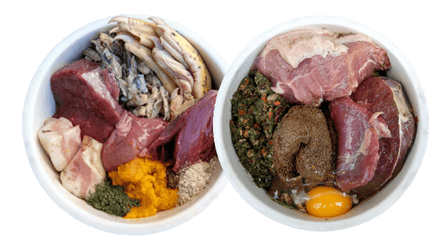
Not only will you have to shop and measure, but you’ll also need
to prepare and then ensure that your prep area remains separate
and clean after each feeding. Since puppies feed three to four
times a day, this could get tedious.
However, many dog lovers swear by the benefits of raw feeding.
If you do have the time and care to devote to this endeavor, raw
feeding may be for you. Let’s talk pros and cons:
Barf Diet Pros & Cons
Minimally Processed
Food remains in its original, whole form. It goes right from your grocer, to you, and then to your dog.
Reduced Risk of Bloat
Because of its lack of processing and all-natural ingredients, there is less of a chance that your dog’s stomach will be bloated. It’s worth considering for puppies with allergies.
Healthier Teeth and Gums
Biting into raw muscle and bone strengthens a puppy’s teeth and jaw.
High In Fat
Animal meats become increasingly
expensive the leaner they get, so
manufacturers may go for fattier cuts
and transfer these costs to you.
Raw Meat Germs
The most significant risk of all is the one
posed to you and your family from
bacteria that live on raw meat. Consider
the fact that it may never be safe to
allow your dog to lick you. Even their
paws may be crawling with bacteria
once they’re finished.
Difficult To Train With
Raw Food
It’s a challenging training with raw food
for two reasons: First off, you can’t keep
wiping your hands on antibacterial wet
wipes every time you reward good
behavior. Secondly, continued raw
feeding during training could lead to
rapid weight gain.
Some dog owners see wet food as the next best thing. If they purchase high-quality
wet food in pouches or canned food with gravy, this is as close to “raw” as they can get without risking the spread of germs and bacteria.
Much Tastier
Wet food feels fresh, and includes gravy.
Its natural moisture makes it way more
flavorful — a fact your puppy will gladly
lap up.
Great To Help Puppies
Transition From Weaning
Because of its moisture, wet food is a
great way to transition young puppies at
eight weeks to 2 months from weaning
into dry food.
Great For Maintaining Weight
Dry food has roughly three to four times
the number of calories per gram than
wet food. If you’re trying to get your
puppy to maintain or reduce weight in a
delicate manner, but would still like to
keep up to volume and frequency of
feedings, wet food may be your answer.
Hard To Store Long-Term
Once you buy wet food, there’s an
expiration date on them, meaning it’s
harder to store. Warm areas with
sunlight are not the right place to keep
these. And when you’ve popped the lid
open, you can only keep wet food for a
couple of hours. If your dog doesn’t eat
it all in one go, you risk the food spoiling
in the open air.
Can Be Processed
Unlike the raw food diet, wet food is still
processed by manufacturers.

